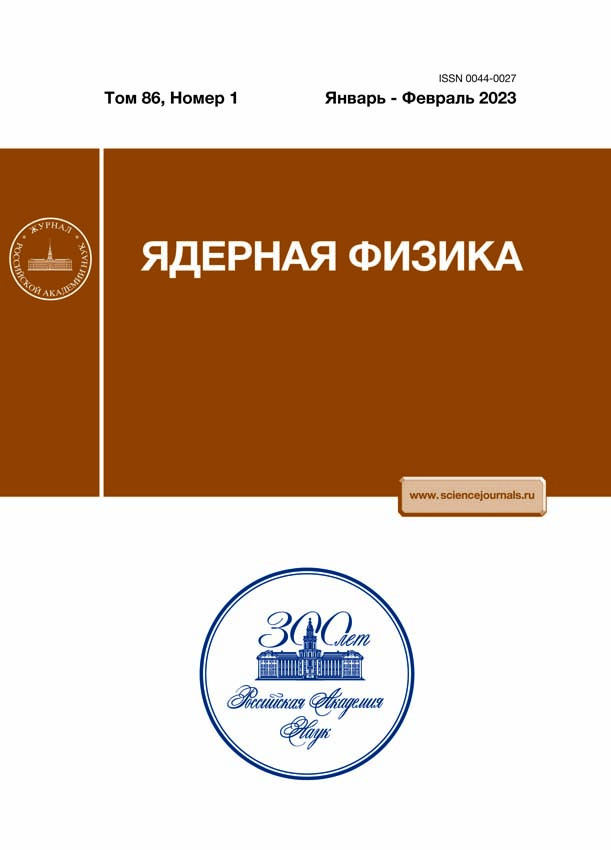ФРАКТАЛЬНЫЙ АНАЛИЗ МОНТЕ-КАРЛО AuAu-СОБЫТИЙ ПРИ ЭНЕРГИИ \(\boldsymbol{\sqrt{s_{NN}}=200}\) ГэВ
- Авторы: Дедович Т.Г.1,2, Токарев М.В.1,2
-
Учреждения:
- Объединенный институт ядерных исследований
- Государственный университет ‘‘Дубна’’
- Выпуск: Том 86, № 1 (2023)
- Страницы: 276-284
- Раздел: МАТЕРИАЛЫ LXXII МЕЖДУНАРОДНОЙ КОНФЕРЕНЦИИ “ЯДРО-2022: ФУНДАМЕНТАЛЬНЫЕ ВОПРОСЫ И ПРИЛОЖЕНИЯ”. Элементарные частицы и поля. Теория
- Статья опубликована: 01.03.2023
- URL: https://medjrf.com/0044-0027/article/view/674773
- DOI: https://doi.org/10.31857/S0044002723010154
- EDN: https://elibrary.ru/RBASAL
- ID: 674773
Цитировать
Полный текст
Аннотация
Представлены результаты фрактального анализа Монте-Карло AuAu-событий при энергии \(\sqrt{s_{NN}}=200\) ГэВ, полученные методом систем уравнений степенных покрытий (SePaC). Для генерации событий использовалась мультифазная транспортная модель AMPT. В качестве исследуемой переменной рассматривался поперечный импульс \(p_{t}\) отрицательно заряженных частиц, регистрируемых в интервале псевдобыстрот \(|\eta|<0.5\) в событиях с различной центральностью от (0–5)\({\%}\) до (30–40)\({\%}\). Для сравнительного анализа рассматривались наборы случайных событий и Монте-Карло фракталы. Показаны различия в поведении зависимости доли событий, реконструируемых как фракталы, от параметров метода для разных типов данных. Найдены оптимальные значения параметров для анализа AMPT AuAu-событий. Отмечается зависимость доли событий Prtn, восстанавливаемых как фракталы, от центральности и множественности в AuAu и случайных событиях, соответственно. Установлены незначительные различия в поведении распределений по размерности \(D_{F}\) для разных классов центральности. В AMPT AuAu-событиях выделены два класса, различающиеся формой спектров по поперечным импульсам.
Об авторах
Т. Г. Дедович
Объединенный институт ядерных исследований; Государственный университет ‘‘Дубна’’
Email: tdedovich@yandex.ru
Россия, 141980, Дубна; Россия, 141980, Дубна
М. В. Токарев
Объединенный институт ядерных исследований; Государственный университет ‘‘Дубна’’
Автор, ответственный за переписку.
Email: tokarev@jinr.ru
Россия, 141980, Дубна; Россия, 141980, Дубна
Список литературы
- E. Akkermans, G. V. Dunne, and A. Teplyaev, Phys. Rev. Lett. 105, 230407 (2010).
- D. G. Moore and V. H. Satheeshkumar, Phys. Rev. D 90, 024075 (2014).
- P. V. Buividovich, T. Kalaydzhyan, and M. I. Poli- karpov, Phys. Rev. D 86, 074511 (2012).
- M. K. Ghosh, P. K. Haldar, S. K. Manna, A. Mukho- padhyay, and G. Singh, DAE Symp. Nucl. Phys. 54, 590 (2009).
- A. Deppman, Phys. Rev. D 93, 054001 (2016).
- N. G. Antoniou, N. Davis, and F. K. Diakonos, Phys. Rev. C 93, 014908 (2016).
- I. Zh. Bunzarov, N. Y. Chankova-Bunzarova, and O. V. Rogachevsky, Phys. Part. Nucl. Lett. 11, 404 (2014).
- J. D. Bjorken, Phys. Rev. D 45, 4077 (1992).
- Z.-W. Lin and C. M. Ko, Phys. Rev. C 65, 034904 (2002).
- Z.-W. Lin, C. M. Ko, B.-A. Li, B. Zhang, and S. Pal, Phys. Rev. C 72, 064901 (2005).
- T. G. Dedovich and M. V. Tokarev, Phys. Part. Nucl. Lett. 10, 481 (2013).
- T. G. Dedovich and M. V. Tokarev, Phys. Part. Nucl. Lett. 10, 491 (2013).
- T. G. Dedovich and M. V. Tokarev, Phys. Part. Nucl. Lett. 13, 169 (2016).
- T. G. Dedovich and M. V. Tokarev, Phys. Part. Nucl. Lett. 9, 552 (2012).
- T. G. Dedovich and M. V. Tokarev, Phys. Part. Nucl. Lett. 13, 178 (2016).
- T. G. Dedovich and M. V. Tokarev, Phys. Part. Nucl. Lett. 14, 865 (2017).
- T. G. Dedovich and M. V. Tokarev, Phys. Part. Nucl. Lett. 16, 240 (2019).
- T. G. Dedovich and M. V. Tokarev, Phys. Part. Nucl. Lett. 18, 93 (2021).
- F. Hausdorff, Math. Ann. 79, 157 (1918).
Дополнительные файлы











